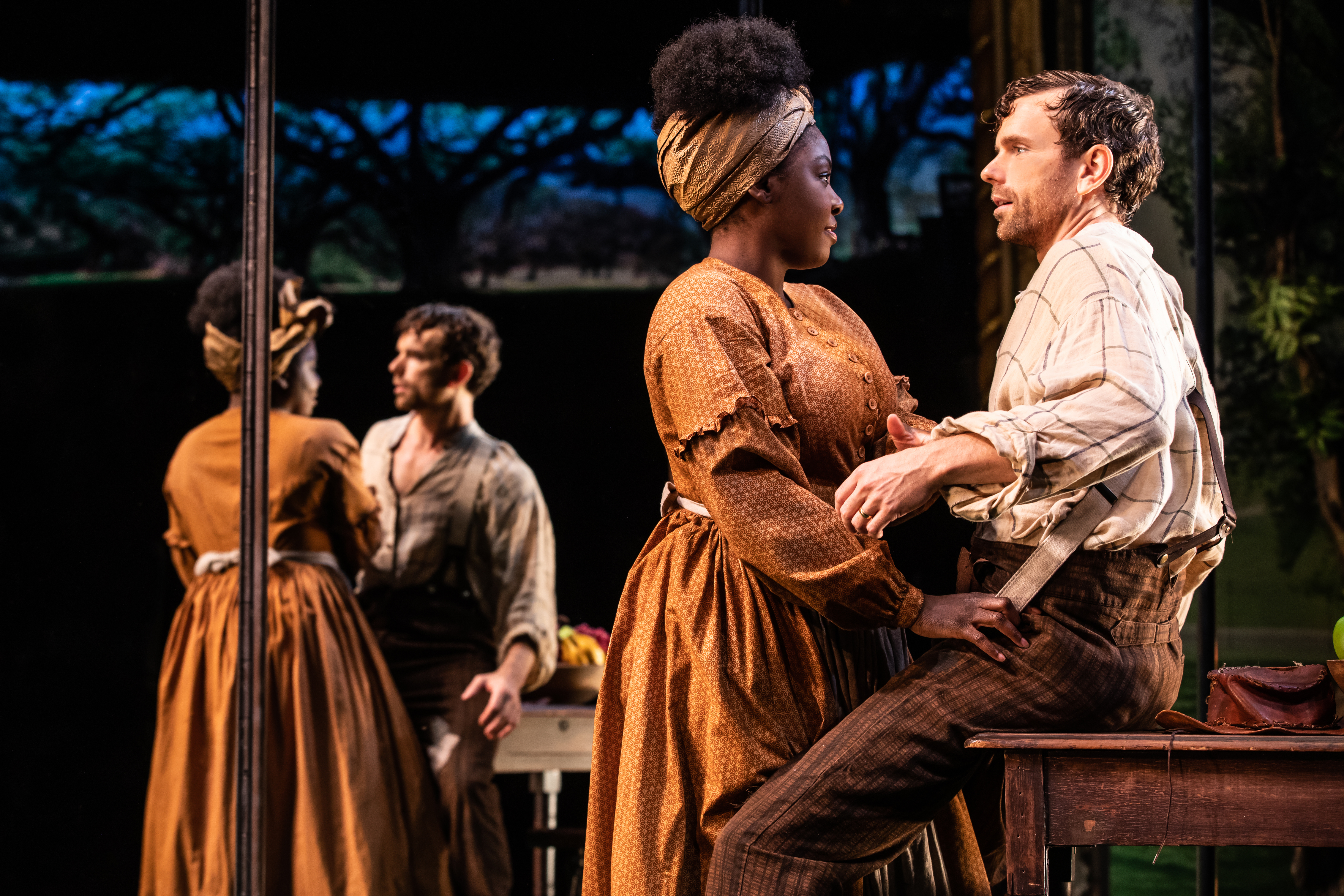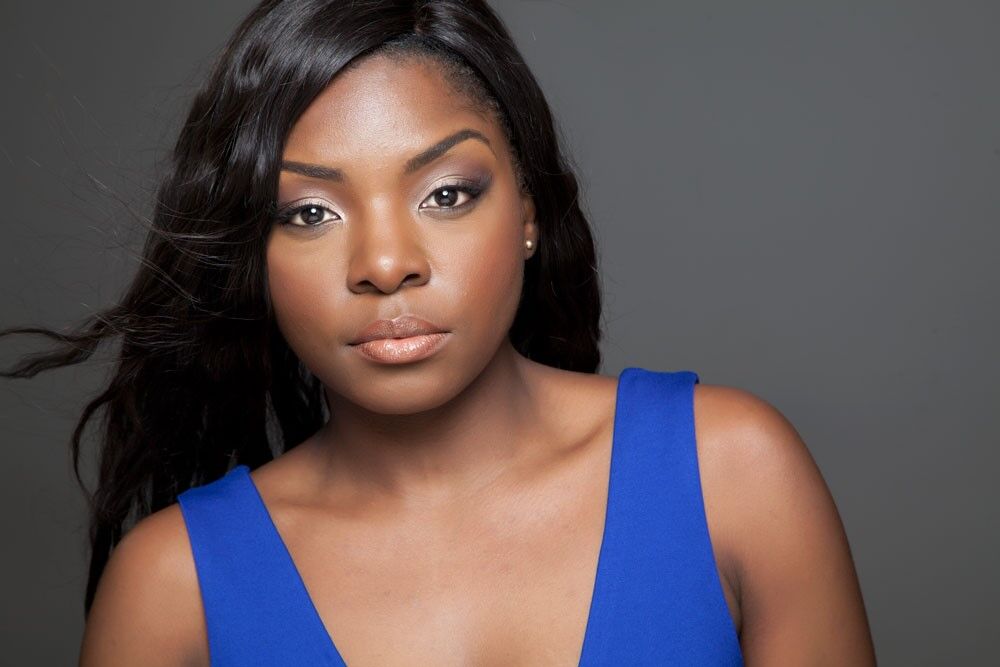Joaquina Kalukango’s Kaneisha is perhaps the most complicated character in Broadway’s “Slave Play.” Jeremy O. Harris’ play is drawing rave reviews for its honest and shocking portrayal of interracial relationships, and how they have been deeply impacted by sex, power, inequality, mental illness, and, most importantly, history. “History,” in this case, is the legacy of slavery, and the story of “Slave Play” hinges on the sexual relationships that once transpired on an antebellum plantation.
Kalukango was last seen on Broadway in “The Color Purple.” Her other theater credits include “Holler If You Hear Me” and “Godspell,” and Off-Broadway’s “Red Letter Plays: F-ing A” and “Hurt Village.” She received a Drama Desk Award nomination for the latter. Kalukango also appears in Ava DuVernay’s Exonerated Five miniseries “When They See Us.”
We talked to Kalukango about “Slave Play,” its ambiguities and the questions it raises, and why her monologue is so special.
“Slave Play” is playing at the Golden Theatre through January 19.
W&H: What’s it like to be a woman in theater today, particularly at a time when more roles for women are being written than perhaps ever before?
JK: It’s an exciting time, specifically with this play. As a black woman, I’ve never gotten a chance in a play to do a monologue that goes on for 10 pages. Just the sheer joy in that and the terror in that is exciting. Jeremy [Harris] did that so well to where this woman is so silent for a lot of the second act, and you have to listen to this black woman deal with her complex thoughts in the entire third act. It’s honestly a joy and a really exciting time in this time where more narratives are coming out for black women.
W&H: “Slave Play” is a very deep exploration of relationships, sexual assault, and race. What were your initial thoughts when you received the script?
JK: I had to read it a few times. The first read, I was shocked. I thought, what did I just read? I did not clock anything I had just read. I had to read it a couple of times to find my understanding. I have to say that “Slave Play” is the play that keeps giving because we keep rediscovering and exploring new things that come up. There’s just a lot to unpack in this play, and it’s beautiful to find those discoveries every night.
I was excited because I knew this was a play that would definitely spark a lot of conversation afterward. This play gave a lot more questions than answers, and it allows the audience members to really do the work and start unpacking and talking about these things. I like that. We don’t give a clear cut ending. I wanted to find out what happens to the characters. I very much felt unresolved. I thought that was exciting to be a part of. Jeremy is so smart with how this play completely unfolds, from one moment to the next moment.

Kalukango and Paul Alexander Nolan in “Slave Play”: Matthew Murphy
W&H: Your character, Kaneisha, is such an interesting character who goes through so much trauma in the play. Please talk about her evolution as the play unfolds.
JK: This is a character I don’t know if I’ll ever fully understand. It’s someone I have to keep exploring every night and I kind of love that. She represents a lot of things. The fact that she has a disorder, as well, and what that does to her and on top of what they do in this exploration is juicy and a lot to play. It’s hard living in somebody so easily triggered by anything and somebody who can truly go from zero to 100. I honestly have to warm up my body and go along for the ride and feel free to respond to anything that comes to me.
W&H: Can you please talk about your collaboration with playwright Jeremy O. Harris and director Robert O’Hara?
JK: It’s a dream. I’ve worked with Robert before [on “The Mountaintop”]. There is no question if what he means when he says it. It’s very clear. There is no filter. It’s so honest and true. Being in a room to have a director who fully led us — he had a very clear vision about how he wanted to see this play done and be truthful to everything Jeremy wrote on the page. I respected that two African American men take these roles and handle them with care and leadership and not compromise the work. When it was announced that the play was going to Broadway, they said they weren’t changing anything.
The great thing about Jeremy is that when he got into the room, because I was the new person, and they let me explore my character. In that exploration, Jeremy wrote some new things for me to play around with. It was a very collaborative process. It was quick — three weeks of rehearsal. We were up on our feet the second or third day.
W&H: What was it like playing alongside your fellow actors?
JK: Act II is one of the best experiences I have had in play. Everyone is fully committed and so free in their instruments. I trust everyone so much that exploration and spontaneity can happen every night. Everyone has your back and you trust everyone so much to carry the work and the weight of the work.
W&H: What is the reaction like when you meet audience members after the show?
JK: Sometimes it’s hard. Some nights I take a while to decompress and take a while that I don’t make it out to see people. Some nights, people say, “Thank you for representing me, I’ve never seen myself on the stage before.” Some people are disgusted and fully triggered who need to go away and digest it. There are some really great fans who are just appreciative of the work and need to process.
This is a play you have to see more than once. Reading it, there was just shock the first round: “I don’t know if I can get through the next 45 minutes.” You have to brace yourself for the rest of the play. This play is very specific to where you are in your own journey. Even in the last scene with the last sentence, their interpretation of what that means can change for each person so drastically.
W&H: Do you tend to be quite purposeful about choosing your roles?
JK: I’ve been blessed to be a part of a lot of the work I’ve been a part of. I can’t do fluff. There is a certain point in your career when you get back to why you’re doing the work and legacy really means something. I’ve been lucky to be a part of such incredible and impactful work. My decisions may not have been purposeful before but they are definitely now.
W&H: You’ve been very fortunate to work with black women on very important projects, such as Ava DuVernay’s “When They See Us.” As a black actress, how often do roles like that come along for you?
JK: This was a good year. Last year I was home taking care of my father while he was in hospice care, so I wasn’t a part of the entertainment industry — in a beautiful way. Now we are entering a different time in television. I’m really excited about the narratives coming out and being explored. We have so many streaming networks that the scope of what can be produced and seen is really exciting. There are amazing writers, and I’m trying to write now. This is definitely a major, different year than other years. Sometimes it’s just every two years.
W&H: Do you think more doors are opening because of the #MeToo movement?
JK: I can’t ignore that fact. I think everybody is fed up. We’re all tired of seeing the same things. We want to see different narratives and stories and put them out there.







